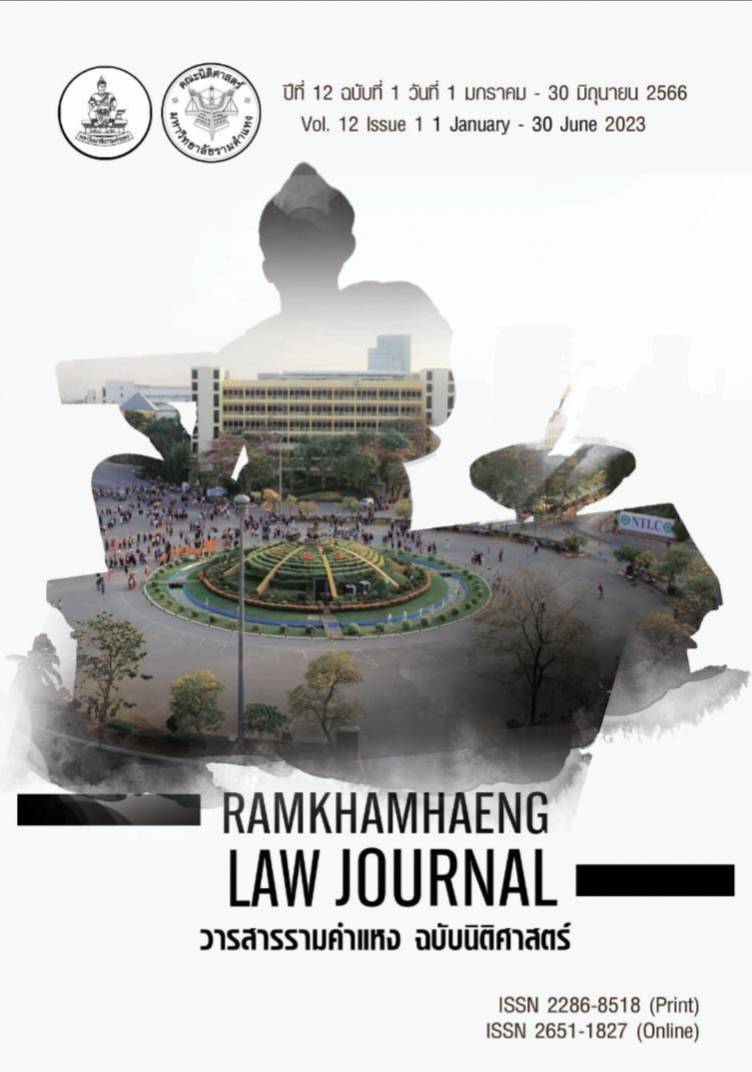ปัญหาการเข้าถึงยาตามกรอบความตกลงที่ครอบคลุมและก้าวหน้าสำหรับหุ้นส่วนทางเศรษฐกิจภาคพื้นแปซิฟิก (CPTPP): ศึกษากรณีกฎหมายสิทธิบัตรของประเทศไทย
Main Article Content
Abstract
การวิจัยเรื่อง ปัญหาการเข้าถึงยาตามกรอบความตกลงที่ครอบคลุมและก้าวหน้าสำหรับหุ้นส่วนทางเศรษฐกิจภาคพื้นแปซิฟิก (CPTPP): ศึกษากรณีกฎหมายสิทธิบัตรของประเทศไทย มีวัตถุประสงค์เพื่อศึกษาความหมาย แนวคิด และทฤษฎีในการคุ้มครองสิทธิบัตรยา และศึกษาบทบัญญัติการให้ความคุ้มครองสิทธิบัตรยาภายใต้ความตกลง CPTPP เปรียบเทียบกับความตกลง TRIPs ภายใต้องค์การค้าโลก (WTO) รวมถึงศึกษาบทบัญญัติดังกล่าวต่อการเข้าถึงยากับกฎหมายสิทธิบัตรของประเทศไทย
ผลการวิจัยพบว่า บทบัญญัติในความตกลง CPTPP ที่เกี่ยวกับสิทธิบัตรยา ทั้งส่วนที่ถูกระงับใช้ไว้ชั่วคราว อันได้แก่ สิ่งที่จะสามารถจดสิทธิบัตรได้ การขยายระยะเวลาการคุ้มครองสิทธิบัตร การผูกขาดข้อมูลทางยา และส่วนที่มีผลใช้บังคับทันทีอย่างการเชื่อมโยงระบบสิทธิบัตรกับการขึ้นทะเบียนยานั้น ล้วนแต่เป็นบทบัญญัติที่มีมาตรฐานสูงกว่าความตกลง TRIPs และไม่มีปรากฎในพระราชบัญญัติสิทธิบัตร พ.ศ. 2522 ของประเทศไทย ซึ่งหากประเทศไทยตัดสินใจเข้าร่วมเป็นภาคีในความตกลง CPTPP อันเป็นผลให้ต้องนำบทบัญญัติเหล่านี้มาบังคับใช้ด้วยนั้นจะก่อให้เกิดปัญหาในการเข้าถึงยา นอกจากนี้ในประเด็นการบังคับใช้มาตรการบังคับใช้สิทธิเหนือสิทธิบัตรยา (Compulsory Licensing: CL) นั้น แม้บทบัญญัติในความตกลงดังกล่าวจะยืนยันว่าประเทศไทยยังคงสามารถใช้ CL ได้ก็ตาม แต่ประเทศไทยอาจเสี่ยงที่จะถูกฟ้องร้องจากเจ้าของสิทธิบัตรยาได้ ผู้วิจัยเห็นว่าประเทศไทยไม่ควรที่จะเข้าร่วมเป็นภาคีในความตกลงดังกล่าว เพราะจะทำให้ประเทศไทยต้องประสบปัญหาในการเข้าถึงยา อย่างไรก็ดีหากพิจารณาในด้านอื่นๆของความตกลงแล้วประเทศไทยเห็นว่าการเข้าร่วมความตกลงดังกล่าว จะก่อให้เกิดประโยชน์กับประเทศไทยมากกว่า และตัดสินใจที่จะเข้าร่วมกับความตกลงดังกล่าว ประเทศไทยต้องทำการแก้ไขพระราชบัญญัติสิทธิบัตร พ.ศ. 2522 โดยเฉพาะเรื่องการเชื่อมโยงระบบสิทธิบัตรกับการขึ้นทะเบียนยา ซึ่งเป็นบทบัญญัติที่มีผลใช้บังคับทันทีหลังจากที่ประเทศไทยเข้าร่วมเป็นภาคี โดยให้มีการเพิ่มส่วนที่เกี่ยวกับ “มาตรการสำหรับสิทธิบัตรยา” เข้าไปเป็นส่วนที่ 7 ในหมวดที่ 2 ทั้งนี้เพื่อรองรับการเข้าร่วมเป็นภาคีในความตกลงดังกล่าว
Article Details

This work is licensed under a Creative Commons Attribution-NonCommercial-NoDerivatives 4.0 International License.
References
จิรศักดิ์ รอดจันทร์. สิทธิบัตร: หลักกฎหมายและแนววิธีปฏิบัติเพื่อการคุ้มครองการประดิษฐ์และ
การออกแบบผลิตภัณฑ์. กรุงเทพมหานคร: สำนักพิมพ์แห่งจุฬาลงกรณ์มหาวิทยาลัย,
จุมพล ภิญโญสินวัฒน์ และภูมินทร์ บุตรอินทร์. ประวัติศาสตร์และแนวคิดเกี่ยวกับทรัพย์สินทาง
ปัญญา. กรุงเทพมหานคร: โครงการตำราและเอกสารประกอบการสอน คณะนิติศาสตร์
มหาวิทยาลัยธรรมศาสตร์, 2561.
ชูเพ็ญ วิบุลสันติ, ภาวิดา ลิ้มตระกูล และวิชชาดา พงศ์พฤกษา. “ความเห็นต่อผลกระทบของการประกาศใช้สิทธิเหนือสิทธิบัตรยาต่อประชาชน รัฐบาล บริษัทยา และเศรษฐกิจของประเทศไทย: ศึกษากรณีบุคลากรทางการแพทย์ในจังหวัดเชียงใหม่.” ไทยเภสัชศาสตร์และวิทยาการสุขภาพ 4, 3 (September 2009): 252-264.
บริษัทโบลลิเกอร์ แอนด์ คอมพานี (ประเทศไทย) จำกัด. โครงการศึกษาการเข้าร่วมความตกลงที่
ครอบคลุมและก้าวหน้าสำหรับหุ้นส่วนทางเศรษฐกิจภาคพื้นแปซิฟิก (CPTPP).
กรมเจรจาการค้า กระทรวงพาณิชย์. กรุงเทพมหานคร: กรมเจรจาการค้า กระทรวงพาณิชย์,
ศุทธินี สัตอาจหาญปรีชา. “COVID-19 Vaccine.” วารสารเพื่อการวิจัยและพัฒนา องค์การเภสัชกรรม 28, 1 (เมษายน-กันยายน 2564): 12-16.
อำนาจ เนตยสุภา และชาญชัย อารีวิทยาเลิศ. คำอธิบายกฎหมายลิขสิทธิ์. พิมพ์ครั้งที่ 2 กรุงเทพมหานคร: สำนักพิมพ์วิญญูชน, 2558.
Bently, Lionel and Brad Sherman. Intellectual Property Law. 4th ed. Oxford: Oxford
University Press, 2014.
Bhardwaj, Ravikant. K. D. Raju, and Manchikanti Padmavati. “The impact of patent linkage on marketing of generic drugs.” Journal of Intellectual Property Rights 18, 4 (January 2013): 316-322.
Cornish, William R. Intellectual Property: Patent, Copyright, Trademarks and
Allied Right. London: Sweet & Maxwell, 1999.
Davies, D. Seaborne. “The Early History of the Patent Specification.” Law Quarterly
Review 50 (April 1934): 86-109.
Drahos, Peter. A Philosophy of Intellectual Property. Hampshire: Ashgate
Publishing Limited, 1996.
_______. “BITS and BIPS: Bilateralism in Intellectual Property.” Journal of World
Intellectual Property 4, 6 (January 2001): 791-808.
Fromer, Jeanne C. “Expressive Incentives in Intellectual Property.” Virginia Law
Review 98 (December 2012): 1746-1824.
Gleeson, Deborah and others. “The Trans Pacific Partnership Agreement, Intellectual property and Medicines: Differential Outcomes for Developed and Developing countries.” Global Social Policy 18, 1 (October 2018): 7-27.
Khan, Muhammad Aamir. Naseeb Zada and Kakali Mukhopadhay. “Economic
implications of the Comprehensive and Progressive Agreement for Trans-
Pacific Partnership (CPTPP) on Pakistan: a CGE approach.” Journal of
Economic Structures 7, 2 (January 2018): 1- 20.
Li, Chunding and John Whalley. “Effects of the Comprehensive and Progressive
Agreement for Trans-Pacific Partnership.” The World Economy 44, 5 (May
: 1312-1337.
Liu, Kung-Chung. and Julien Chaisse (eds). The Future of Asian Trade Deals and IP.
Oxford: Hart Publishing, 2019.
Machlup, Fritz and Edith Penrose. “The Patent Controversy in the Nineteenth
Century.” Journal of Economic History 10, 1 (May 1950): 1-29.
Matthews, Dunkan. “TRIPS flexibilities and access to medicines in developing
countries: The problem with technical assistance and free trade
agreements.” European Intellectual Property Review 11 (2005): 420-427.
Musungu, Sisule F. and Cecilia Oh. The use of flexibilities in TRIPs by developing
countries: can they promote access to medicine?. Geneva: The South
Centre, 2006.
Petri, Peter A. and Michael G. Plummer. “Should China Join the New Trans-Pacific
Partnership?.” China & World Economy 28, 2 (March 2020): 18-36.
Pusceddu, Piergiuseppe. “Assessing Access to Medicines in Preferential Trade
Agreements: From the Trans-Pacific Partnership to the Comprehensive and
Progressive Agreement for Trans-Pacific Partnership.” International Review
of Intellectual Property and Competition Law 49 (October 2018): 1048–
Roffe, Pedro. Bilateral Agreement and TRIPs plus World: The Chile-USA Free
Trade Agreement. Ottawa: Quaker International Affairs Program, 2004.
Son, Kyung-Bok. and others. “Moderating the Impact of Patent Linkage on Access to
Medicines: Lessons from Variations in South Korea, Australia, Canada, and
the United States.” Globalization and Health 14 (October 2018): 2.
Upreti, Pratyush Nath. “From TPP to CPTPP: why intellectual property matters.”
Journal of Intellectual Property Law & Practice 13, 2 (February 2018): 100.
Valdes, Raymundo. and Maegan McCann. Intellectual Property Provisions in
Regional Trade Agreements: Revision and Update’ in Rohini Acharya,
Regional Trade Agreement and the Multilateral Trading System. UK:
Cambridge University Press, 2016.
Van Den Bossche, Peter. The Law and Policy of the World Trade Organization.
nd ed. Cambridge: Cambridge University Press, 2008.
Velasquez, German. Vaccines, Medicines and COVID-19 How Can WHO Be Given a
Stronger Voice?. Geneva: South Center, 2021.
VJ, Moir H. and others. “The Trans Pacific Partnership Agreement and Access to HIV
Treatment in Vietnam.” Global Public Health 13 (2018): 400-413.
WHO, WIPO and WTO. Promoting Access to Medical Technologies and Innovation Intersections between Public Health Intellectual Property and Trade.
Geneva Switzerland: WHO, WIPO, WTO, 2013.
Wu, Chien-Huei. “ASEAN at the Crossroad: Trap and Track between CPTPP and
RCEP.” Journal of International Economic Law 23, 1 (March 2020): 97-117.
Yap, Yan Yee and others. “Trans-Pacific Partnership Agreement and Its Impact on
Accessibility and Affordability of Medicines: A Meta-Synthesis.” Therapeutic
Innovation and Regulatory Science 51, 4 (March 2017): 446-459.

